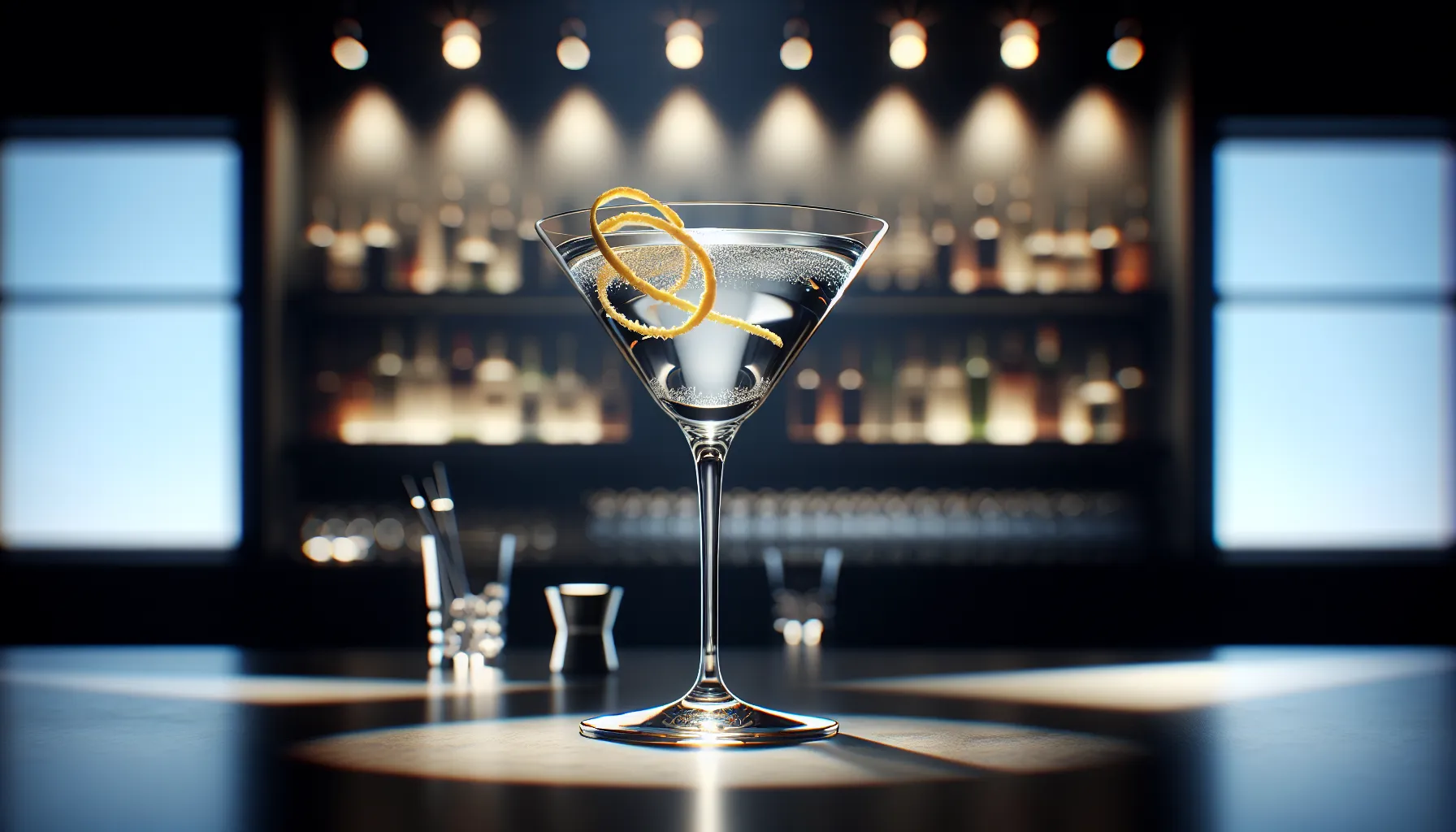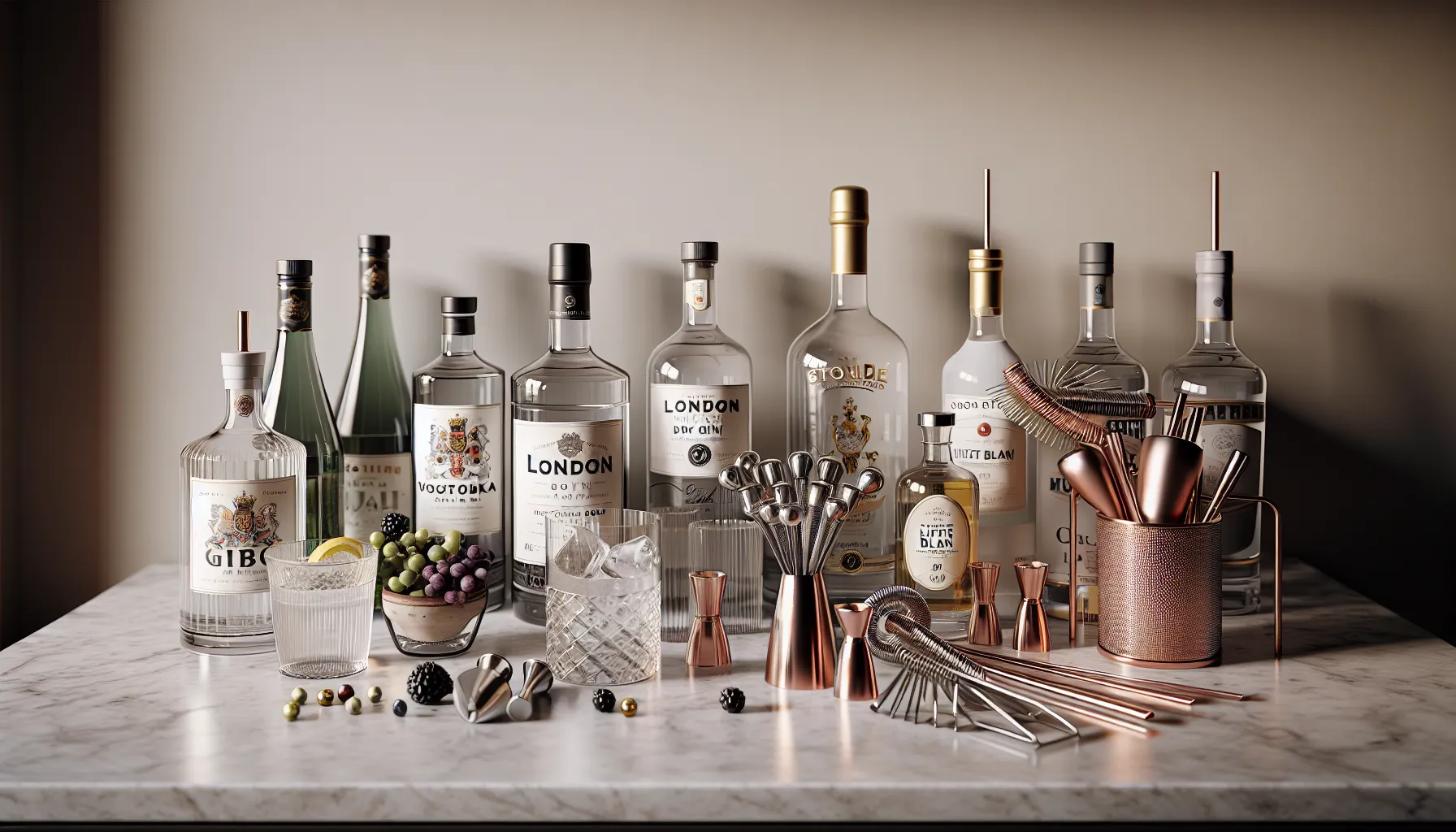Key Takeaways
- The Vesper martini blends gin, vodka, and an aromatized wine, made famous by James Bond in Casino Royale; it’s crisp, strong, and citrus‑forward with a lemon peel garnish.
- Follow the IBA recipe: 6 cl gin, 1.5 cl vodka, 0.75 cl Lillet Blanc; shake hard and strain into a chilled cocktail glass, or stir for a silkier texture.
- Choice of aperitif shapes flavor: Lillet Blanc gives a softer profile, while Cocchi Americano offers a closer Kina Lillet‑style bite and firmer quinine edge.
- Pick a dry, high‑proof London Dry gin and a clean 40% vodka; keep everything ice‑cold, use large clear ice, and fine strain for clarity.
- Glassware matters: serve up in a chilled coupe or cocktail glass; a deep champagne goblet nods to Bond’s original order.
- Dial in balance by tweaking the aperitif (drier at 0.33 oz, brighter at 0.5 oz) and adjusting the gin‑to‑vodka ratio to match strength and aroma.
I love a drink with a story. The Vesper martini hooked me the first time I read Bond order one. It feels sleek and bold. It looks like moonlight in a glass. It tastes crisp with a hush of citrus.
In this guide I’ll share what makes the Vesper special. We’ll touch the core spirits and the right chill. We’ll talk glassware and the stir versus shake debate. I’ll keep it simple and fun. By the end you’ll know how to make one with style.
So grab your favorite gin and vodka and a bright aperitif. Chill that glass. Lets build a Vesper that feels like a secret handshake.
What Is A Vesper Martini?
A Vesper martini is a mixed-spirit martini made with gin, vodka, and aromatized wine, created on the page by Ian Fleming in Casino Royale in 1953 (Source: Fleming, Casino Royale, 1953).
I use the IBA spec for clarity, and I reference the Bond spec for context (Source: International Bartenders Association; Fleming, Casino Royale, 1953).
| Recipe | Gin | Vodka | Aromatized wine | Technique | Garnish | Glass |
|---|---|---|---|---|---|---|
| IBA standard | 6 cl | 1.5 cl | 0.75 cl Lillet Blanc | Shake, strain | Lemon peel | Chilled cocktail glass |
| Bond original | 3 measures | 1 measure | 0.5 measure Kina Lillet | Shake, strain | Large lemon peel | Deep champagne goblet |
- Defined by composition, the Vesper blends juniper driven gin, neutral vodka, and a bittersweet wine aperitif (Source: IBA).
- Built on London dry gin strength, examples include Gordon’s and Tanqueray, for a crisp core.
- Balanced with clean vodka structure, examples include Absolut and Smirnoff, to stretch the botanicals.
- Brightened with an aromatized wine, examples include Lillet Blanc and Cocchi Americano, since Kina Lillet ceased in 1986 (Source: Lillet, brand FAQ; Difford’s Guide).
- Finished with a wide lemon peel, the oils add a sharp citrus top note over a dry finish (Source: IBA).
I follow the IBA direction to shake until ice cold, then I strain into a chilled cocktail glass for clarity and snap, and I use a generous lemon peel for aroma (Source: IBA). I note Bond’s call for a deep champagne goblet in the novel for historical context (Source: Fleming, Casino Royale, 1953).
The Vesper Martini’s Origins And James Bond Connection

The Vesper martini’s origins and James Bond connection start in print, in 1953. I trace the recipe to Ian Fleming’s novel Casino Royale, where Bond orders “three measures of Gordon’s, one of vodka, half a measure of Kina Lillet,” shaken, ice cold, with a large lemon peel, and names it after Vesper Lynd (Ian Fleming, Casino Royale, 1953, ch. 7; British Library). I reference the International Bartenders Association for the modern codification, which lists gin, vodka, and Lillet Blanc in a 6:1.5:0.75 cl ratio, stirred or shaken, and strained into a chilled cocktail glass with a lemon zest garnish (IBA).
I connect the vesper martini’s flavor shift to ingredient changes. I note that Kina Lillet, the original aromatized wine, no longer exists, since Lillet reduced quinine and sweetness in the 1980s, creating the current Lillet Blanc with a softer, less bitter profile (Lillet; Difford’s Guide). I prefer Cocchi Americano when I want a closer quinine bite, since it preserves a gentian‑quinine backbone similar to historical Kina Lillet references (Difford’s Guide).
I keep the service details aligned with Fleming’s text and bar practice. I cite Bond’s “deep champagne goblet” call as a period detail, though I pour into a chilled cocktail glass for balance and temperature retention (Ian Fleming, Casino Royale, 1953). I keep the drink’s identity anchored to its mixed‑spirit base, since the split of juniper‑led gin and neutral vodka defines the vesper martini’s clean, firm structure (IBA).
Timeline of the vesper martini and Bond connection
| Year | Event | Source |
|---|---|---|
| 1953 | Casino Royale publishes Bond’s original Vesper order and name | Ian Fleming; British Library |
| 1962 | Dr. No debuts Bond on film, cementing the “shaken” persona | British Film Institute |
| 1980s | Lillet reformulates, ending Kina Lillet and introducing Lillet Blanc | Lillet; Difford’s Guide |
| 2012 | IBA includes the Vesper in its official cocktail list | IBA |
- Ian Fleming, Casino Royale, 1953, ch. 7, Jonathan Cape; British Library https://www.bl.uk/collection-items/casino-royale-by-ian-fleming
- International Bartenders Association, Vesper https://www.iba-world.com/
- Lillet, History and Products https://www.lillet.com/
- Difford’s Guide, Kina Lillet and Substitutes https://www.diffordsguide.com/
- British Film Institute, James Bond on Screen https://www.bfi.org.uk/
Ingredients And Tools You’ll Need

I match the vesper martini’s crisp profile with clean spirits and cold gear. I keep measurements exact for balance and texture.
Choosing The Right Gin, Vodka, And Aperitif
Choosing the right gin, vodka, and aperitif sets the vesper martini’s structure and aroma. I favor a dry, high-proof London Dry gin, a neutral 40% vodka, and a quinine-leaning aromatized wine for bite.
- Pick London Dry gin for clarity, examples Tanqueray, Beefeater, Hayman’s Royal Dock.
- Pick neutral vodka for texture, examples Ketel One, Stolichnaya, Absolut.
- Pick Lillet Blanc for softness, or Cocchi Americano for Kina-like bitterness.
- Pick a wide lemon peel for lift, then express over the surface.
| Component | Examples | ABV | Key notes | Source |
|---|---|---|---|---|
| Gin, London Dry | Tanqueray, Beefeater, Hayman’s Royal Dock | 44–57% | Juniper, citrus oil, dry finish | IBA style guide, brand tech sheets |
| Vodka, neutral | Ketel One, Stolichnaya, Absolut | 40% | Clean profile, silky weight | Brand tech sheets |
| Aperitif, aromatized wine | Lillet Blanc, Cocchi Americano | 16.5–17% | Citrus, floral, quinine grip | Lillet, Cocchi producer notes |
- Favor Lillet Blanc for a softer take, if I want less bitterness.
- Favor Cocchi Americano for a closer Kina echo, if I want firmer quinine.
Sources: International Bartenders Association for Vesper spec, Lillet producer info for Blanc, Cocchi producer info for Americano.
Essential Bar Tools For Precision
Essential bar tools for precision keep the vesper martini cold, clear, and consistent.
- Use a two-sided jigger for exact ratios, 30 ml, 45 ml.
- Use a Boston shaker for Bond’s shake, or a mixing glass for a stirred variant.
- Use a Hawthorne strainer for fast pour, use a fine strainer for extra clarity.
- Use a long bar spoon for controlled dilution, 30–40 stirs.
- Use large clear ice for slower melt, 4–5 cm cubes work best.
- Use a Y-peeler for a wide lemon peel, use a small knife to trim pith.
- Use a chilled coupe or Nick and Nora for service, use a deep champagne goblet for a period nod.
- Use a digital thermometer for calibration, target -2 to -5 °C in glass.
Sources: IBA for technique notes, Dave Arnold’s Liquid Intelligence for chilling, brand bar manuals for tool specs.
How To Make A Classic Vesper Martini

I make a crisp, aromatic vesper martini with cold gear and clean technique. I stick to the IBA build for accuracy and Bond’s garnish for flair.
Step-By-Step Recipe
- Chill: Freeze a coupe or deep goblet for 10 minutes, freeze the shaker tin, freeze the Hawthorne strainer.
- Measure: Use a jigger for precise pours, use high proof gin for bite, use neutral vodka for clarity, use quinine‑leaning aromatized wine for snap.
- Combine: Add gin, add vodka, add Lillet Blanc or Cocchi Americano, add large clear ice.
- Shake: Shake hard for 12 to 15 seconds for sub‑zero dilution per IBA guidance (IBA Official Cocktails).
- Strain: Double strain into the chilled glass to keep shards out.
- Garnish: Express a wide lemon peel over the surface, rim the glass, drop the peel.
Recipe measures
| Recipe source | Gin | Vodka | Aromatized wine | Method | Garnish |
|---|---|---|---|---|---|
| IBA Standard | 6 cl, 2 oz | 1.5 cl, 0.5 oz | 0.75 cl, 0.25 oz Lillet Blanc | Shake, strain | Wide lemon peel |
| Bond Original | 3 parts | 1 part | 0.5 part Kina Lillet | Shake, strain | Wide lemon peel |
- Source notes: The IBA specifies the above spec and shake method (International Bartenders Association, iba-world.com). Kina Lillet is discontinued, Lillet Blanc replaced it with lower bitterness in the 1980s per the producer, Cocchi Americano offers a nearer quinine profile per Difford’s Guide.
Pro Tips For Balance And Chill
- Pick: Choose a dry London Dry gin, such as Beefeater 47% or Tanqueray 47.3%, choose a clean vodka, such as Absolut 40% or Belvedere 40%, choose Cocchi Americano if you want extra bite.
- Tune: Shift the wine to 0.33 oz for a drier sip, push to 0.5 oz for more citrus and quinine.
- Size: Use 1.25 inch clear cubes or a single 2 inch cube for slower dilution.
- Time: Cap the shake at 15 seconds if your ice is standard bar cubes, extend to 18 seconds if your ice is dense clear cubes.
- Temp: Keep spirits in the fridge for faster chilling, keep glassware frozen for cleaner texture.
- Express: Hold the peel 2 inches above the drink, pinch across the width, wipe the rim, drop it.
- Stir: Stir for 25 to 30 seconds over large cubes if you want a silkier texture, use the same spec for consistency.
- Verify: Taste a test batch side by side, compare Lillet Blanc against Cocchi Americano, log your preferred ratio.
- References: International Bartenders Association iba-world.com, Lillet official site lillet.com, Difford’s Guide diffordsguide.com.
Variations And Modern Twists
Modern riffs keep the Vesper crisp and bold. I tune strength and bitterness without losing the drink’s clean line.
Adjusting The Gin-To-Vodka Ratio
Adjusting the gin-to-vodka ratio changes structure, aroma, and texture. I anchor balance first, then I tweak proof and mouthfeel.
- Favor more gin for structure, if the gin is 47% ABV or lower.
- Raise vodka for neutrality, if citrus oils feel too sharp on the nose.
- Lower total spirit for softness, if using navy strength gin at 57% ABV.
- Split gin styles for detail, if a single bottle reads flat. Examples include London Dry plus Contemporary.
- Match dilution to ratio, if the mix tastes hot. Examples include 12 to 15 rapid shakes and large clear ice.
I reference the IBA spec for baseline balance, then I map changes in share of each component for consistency (IBA).
| Recipe baseline | Gin share | Vodka share | Aperitif share | Notes |
|---|---|---|---|---|
| IBA 6 cl gin, 1.5 cl vodka, 0.75 cl Lillet Blanc | 73% | 18% | 9% | Crisp, juniper forward, light bitterness |
| Bond 3 gin, 1 vodka, 0.5 Kina | 66.7% | 22.2% | 11.1% | Broader mid palate, firmer quinine edge |
Substituting Kina Lillet Today
Substituting Kina Lillet today favors quinine driven aperitifs that echo the original profile. I keep brightness high, then I layer back the bite.
- Pour Cocchi Americano Bianco at 0.75 cl for IBA builds, if targeting a closer Kina analogue. Sources include Difford’s Guide and Punch.
- Use Lillet Blanc at 0.75 cl for a softer sip, if gentian and quinine feel too bitter. Sources include IBA and Lillet.
- Split aperitifs for control, if you want precise bitterness. Examples include 0.5 cl Lillet Blanc plus 0.25 cl Cocchi Americano.
- Add quinine accents sparingly, if only Lillet Blanc is on hand. Examples include 1 to 2 dashes quinine tincture or 0.25 cl Tempus Fugit Kina L’Aéro d’Or as a split. Sources include Tempus Fugit Spirits and Difford’s Guide.
- Balance citrus oils to the aperitif, if the palate leans sweet. Examples include a wider lemon peel for Cocchi or a narrower peel for Lillet.
- IBA Official Cocktails, Vesper Martini, iba-world.com
- Difford’s Guide, Vesper and Kina Lillet pages, diffordsguide.com
- Punch, Cocchi Americano guide, punchdrink.com
- Tempus Fugit Spirits, Kina L’Aéro d’Or, tempusfugitspirits.com
Serving And Presentation
I present the Vesper martini cold, clear, and aromatic. I keep the look minimal, the lines sharp.
Glassware, Temperature, And Garnish
I match the glass, the chill, and the lemon oils to highlight the Vesper’s citrus snap.
- Use a chilled cocktail glass for classic service, IBA lists a chilled cocktail glass with a lemon zest garnish for the Vesper martini, source: International Bartenders Association.
- Use a deep champagne goblet for a period look, Ian Fleming specifies a deep champagne goblet in Casino Royale for Bond’s Vesper, source: Ian Fleming, 1953.
- Use a Nick and Nora when you want a smaller 120–150 ml capacity and tighter aroma focus, source: Difford’s Guide.
- Use a service temperature near -6 to -1 °C for a crisp martini profile, Dave Arnold documents optimal spirit-cocktail service in this range, source: Liquid Intelligence, 2014.
- Use large, hard ice for shaking to reach subzero temperature fast with clean dilution, Arnold details faster chilling and lower aeration with big ice, source: Liquid Intelligence, 2014.
- Use a fine strain if you want glass-clear texture with minimal ice shards, Difford’s Guide notes clarity gains with fine straining, source: Difford’s Guide.
- Use a wide lemon peel 5–7 cm for maximum oils, IBA calls for a wide lemon zest, source: International Bartenders Association.
- Use an expressed zest over the surface, then rim the glass lightly to set citrus aroma without adding pith bitterness, source: Difford’s Guide.
- Use a discard or a neat dock on the rim when the gin is very juniper-forward, the lighter Lillet Blanc or Cocchi Americano balance benefits from aroma without extra peel mass, source: Difford’s Guide, Cocchi.
Numbers and targets
| Aspect | Target | Context | Source |
|---|---|---|---|
| Service temperature | -6 to -1 °C | Shaken or very cold stirred martini class | Liquid Intelligence |
| Glass temperature | -10 to -5 °C | Freezer-chilled 10–20 minutes | Difford’s Guide |
| Lemon peel width | 5–7 cm | Wide cut for higher oil yield | IBA, Difford’s Guide |
| Typical dilution | 20–25% | Large-cube shake, quick strain | Liquid Intelligence |
- Use a freezer-chilled glass, then hold it by the stem to preserve the vesper martini’s chill.
- Use a fast, hard shake to reach target temperature, then fine strain to keep the martini bright.
- Use the lemon peel last, express over the drink, rim lightly, then dock or discard for a clean finish.
Pairings And Occasions
Pairings and occasions for a Vesper martini center on clean flavors, bright citrus, and crisp textures.
- Seafood: oysters, shrimp cocktail, crab legs.
- Salumi: prosciutto, finocchiona, bresaola.
- Cheese: young goat cheese, aged cheddar, Parmigiano Reggiano.
- Vegetables: grilled asparagus, artichoke hearts, Castelvetrano olives.
- Canapés: smoked salmon blinis, lemony tuna tartare, cucumber cups.
- Citrus: lemon peel twists, grapefruit segments, yuzu kosho.
- Crunch: sea salt chips, almond crackers, grissini.
- Brine: cornichons, caper berries, pickled onions.
- Occasions: aperitif hour, black tie events, date nights.
- Venues: hotel bars, tasting rooms, supper clubs.
- Moments: first toast, pre-dinner mingle, late-night nightcap.
- Seasons: spring launches, summer patios, winter galas.
- Menus: seafood towers, sushi omakase, steak frites.
- Courses: amuse-bouches, raw bars, light starters.
- Sequences: Vesper first, white wine second, red wine third.
- Pacing: one Vesper per guest, water alongside, food within reach.
- Adjustments: extra lemon oil, if the gin runs piney.
- Adjustments: a touch more aromatized wine, if the vodka reads hot.
- Adjustments: a saline dash, if the oysters taste sweet.
Numbers and service guide
| Item | Value | Note |
|---|---|---|
| Serving temperature | -6 to -1 °C | Crisp service for spirit-forward cocktails (IBA) |
| Standard pour | 90 ml | Typical up cocktail size in bars |
| Prep time | 60 to 90 seconds | Stirring or shaking to deep chill |
I match intensity, then I match texture, then I match aroma, following classic pairing guidance from WSET and IBA sources.
Conclusion
I hope this nudged you to mix with confidence and a bit of swagger. The Vesper rewards care and a chilled mindset. Trust your palate and keep things clean and cold. When it feels right it is right.
Pour one when you want a moment that feels sharp and unhurried. Share it with a friend or savor it solo. Snap a lemon twist and take that first bright sip. Then let the night decide where you go next.
Frequently Asked Questions
What is a Vesper martini?
A Vesper martini is a mixed-spirit cocktail made with gin, vodka, and aromatized wine. It was created by Ian Fleming in Casino Royale and popularized by James Bond. The drink is crisp, bold, and citrus-forward, typically finished with a wide lemon peel for aroma.
What’s the difference between Bond’s original recipe and the IBA version?
Bond’s recipe calls for 3 parts gin, 1 part vodka, and 0.5 part Kina Lillet. The IBA standard uses 6 cl gin, 1.5 cl vodka, and 0.75 cl Lillet Blanc. Since Kina Lillet no longer exists, Lillet Blanc or Cocchi Americano is used to approximate the original profile.
Should a Vesper be shaken or stirred?
Traditionally, martinis are stirred, but Bond specifies shaking. Shaking chills and aerates the drink more, making it extra crisp. Stirring gives a silkier texture. Choose based on preference; both methods work when properly chilled and strained.
What gin and vodka work best in a Vesper?
Use a high-proof, juniper-forward gin for structure and a clean, neutral vodka for balance. London Dry gins perform well. Avoid overly flavored vodkas. Quality spirits matter because the cocktail is spirit-forward with no sweeteners to hide flaws.
What can I use instead of Kina Lillet?
Kina Lillet was discontinued. Lillet Blanc is the common replacement, offering a softer, less bitter profile. For a closer match to the original’s quinine bite, use Cocchi Americano. Adjust the amount to taste to balance bitterness and citrus.
What glass should I serve a Vesper in?
Serve in a chilled cocktail glass for a classic look. For a vintage Bond feel, use a deep champagne goblet. A Nick and Nora glass tightens the aroma and reduces spill risk. Always pre-chill your glass for maximum crispness.
How cold should a Vesper be served?
Aim for -6 to -1 °C (21 to 30 °F). Use large, hard ice to chill efficiently without excessive dilution. Shake or stir until the tin feels painfully cold, then fine-strain into a pre-chilled glass for clarity and snap.
What’s the ideal garnish for a Vesper?
A wide lemon peel. Express the oils over the surface and rim, then drop or discard. This adds bright citrus aroma without bitterness. Avoid olives; they clash with the aromatized wine’s delicate flavors.
How do I balance the flavors in a Vesper?
Start with the standard ratios, then adjust the aromatized wine for sweetness/bitterness and the gin-to-vodka ratio for structure. Higher-proof gin boosts backbone; more vodka softens edges. Keep everything very cold and use large ice to control dilution.
Can I make modern variations of the Vesper?
Yes. Tweak the gin-to-vodka ratio, swap Lillet Blanc with Cocchi Americano, or try a different dry, bitter aperitif. Keep the lemon peel. Maintain balance: juniper structure, clean vodka texture, and a bittersweet wine note.
What foods pair well with a Vesper martini?
Choose clean, bright flavors: oysters, shrimp, smoked salmon, salumi, aged cheeses, marinated vegetables, canapés, and crisp snacks like potato chips. Match intensity and texture. Citrus-driven dishes and light seafood are especially good.
When is a Vesper best enjoyed?
It shines as an aperitif, at black tie events, date nights, and elegant gatherings. Serve before dinner to awaken the palate. It suits cool evenings and festive occasions when a bold, stylish cocktail sets the tone.

